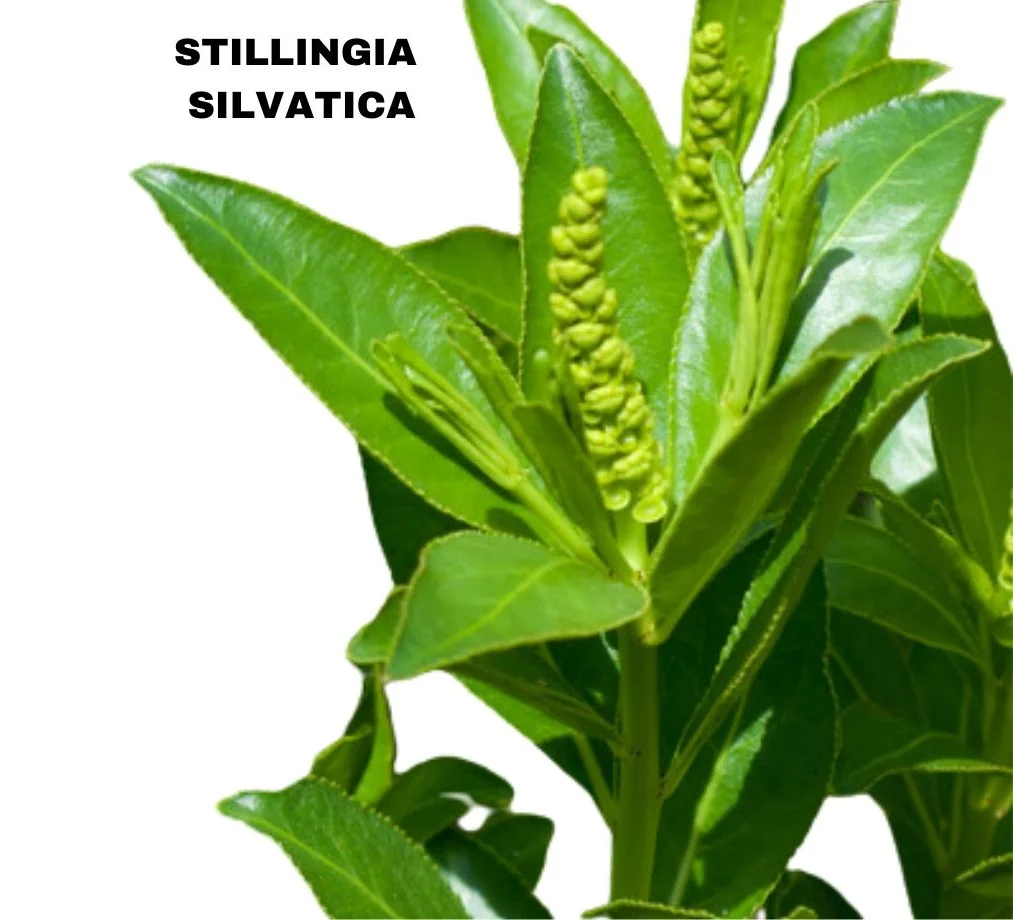Stillingia Silvatica, commonly known as Queen’s Root, is derived from the plant Stillingia sylvatica.
This remedy is used in traditional medicine for its effects on chronic rheumatic conditions, lymphatic and liver disorders, and respiratory issues.
It is particularly noted for its role in treating scrofulous and syphilitic affections.

SOURCE INFORMATION
Scientific Classification
- Kingdom: Plantae
- Order: Euphorbiales
- Family: Euphorbiaceae
- Genus: Stillingia
- Species: Stillingia sylvatica
Origin
- Stillingia Silvatica is native to the eastern United States.
- It has been used in Native American herbal practices and later adopted into Western herbalism for its medicinal properties.
Historical Facts
- Queen’s Root was traditionally used for various ailments, particularly for conditions involving the lymphatic system and chronic skin issues.
- Its use in treating scrofulous and syphilitic conditions has been documented in historical medical texts.
DRUG PATHOGENESIS
Stillingia Silvatica primarily influences:
- Lymphatic System: Acts on chronic conditions involving lymph nodes and lymphatic drainage.
- Respiratory System: Addresses chronic respiratory issues and constriction in the larynx.
- Skin: Targets chronic skin eruptions and ulcers.
KEY CHARACTERISTICS
- Lymphatic and Hepatic Impact: Supports the lymphatic system and liver, particularly in cases of jaundice and constipation.
- Respiratory Relief: Alleviates dry, spasmodic cough and chronic laryngeal irritation.
- Skin Conditions: Useful in managing chronic skin eruptions, ulcers, and secondary syphilitic symptoms.
DETAILED ORGAN SYMPTOMS
MIND
- Gloomy Forebodings: Persistent feelings of dread and depression.
RESPIRATORY SYSTEM
- Dry, Spasmodic Cough: Persistent, non-productive cough.
- Laryngeal Constriction: A sensation of tightness or constriction in the larynx.
- Sore Trachea: Sensitivity or pain in the trachea upon pressure.
- Hoarseness: Chronic hoarseness affecting public speakers.
URINARY SYSTEM
- Colorless Urine: Urine that appears clear but may have white sediment.
- Milky, Thick Urine: Presence of thick, milky deposits in the urine.
EXTREMITIES
- Aching Bones: General aching in the bones of the extremities and back.
SKIN
- Chronic Ulcers: Persistent ulcers, particularly on hands and fingers.
- Enlarged Cervical Glands: Swelling of lymph nodes in the neck.
- Burning Itching: Sensation of burning and itching on the legs, aggravated by exposure to air.
- Exostosis and Scrofuloderma: Abnormal bone growth and skin conditions associated with syphilis.
MODALITIES
- Worse: In the afternoon, damp air, motion.
- Better: In the morning, dry air.
WHAT ARE MODALITIES IN HOMOEOPATHY?
RELATIONSHIP WITH OTHER DRUGS
Compare:
- Staphysagria: For chronic skin issues and syphilitic conditions.
- Mercurius: For similar lymphatic and skin conditions.
- Corydalis: For syphilitic nodes and related symptoms.
DOSE
- Tincture and First Potency: Typically administered in tincture form or in homeopathic potencies ranging from the first to the third.
Frequently Asked Questions
What conditions is Stillingia Silvatica most commonly used for?
- It is used for chronic rheumatic conditions, lymphatic and liver disorders, respiratory issues, and chronic skin conditions, including those related to syphilis and scrofula.
Can Stillingia Silvatica be used for acute conditions?
- It is primarily used for chronic conditions.
- For acute issues, other remedies may be more appropriate.
What should I do if I experience side effects from using Stillingia Silvatica?
- Discontinue use and consult a healthcare provider if side effects or adverse reactions occur.
Glossary of Terms
- Torpor: A state of physical or mental inactivity.
- Periosteal Rheumatism: Pain and inflammation affecting the periosteum (membrane covering bones).
- Scrofulous: Relating to scrofula, a type of tuberculosis affecting the lymph nodes.
- Gleet: Chronic urethral discharge.
- Exostosis: Abnormal bone growth.
